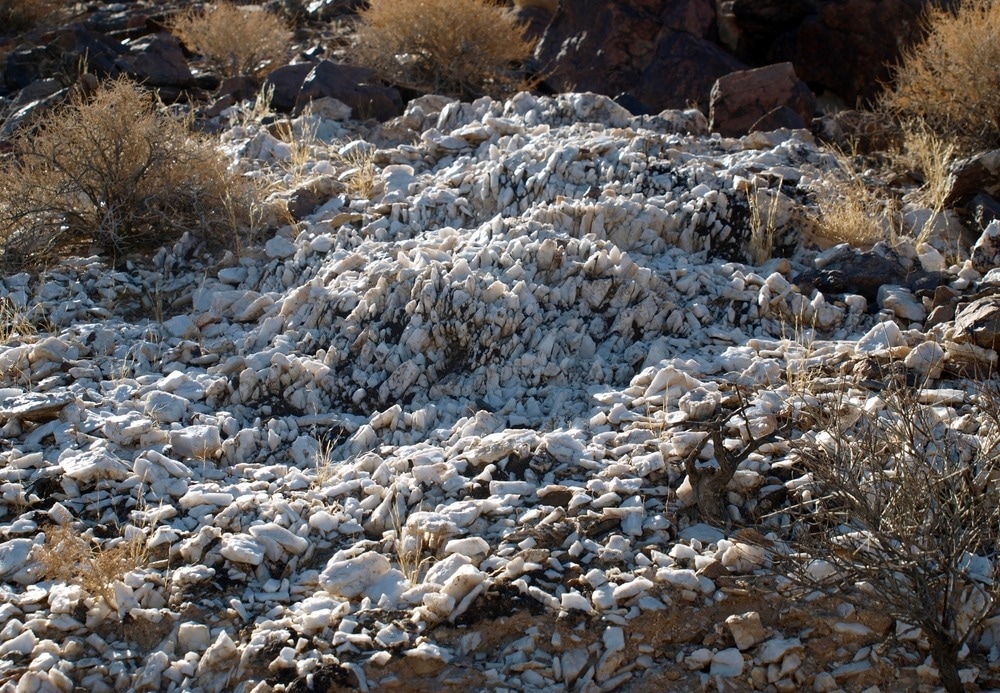Composed of silicon and oxygen, quartz is an abundant mineral crystallized through intense pressure. Quartz is mined commercially because it is in demand for many different applications. It is particularly useful for creating oscillators in computer chips, clocks, and radios. Quartz crystals are also used for jewelry and decorative purposes.

Image Credit: Stillgravity/Shutterstock.com
Quartz can be found in almost every mineral environment and all three rock classes (sedimentary, igneous, and metamorphic). Chemically, quartz is composed of silicon and oxygen atoms with a chemical formula of SiO2.
At the atomic level, the silicon and oxygen atoms are arranged in a continuous framework of tetrahedra, where four oxygen atoms surround a single silicon atom, with the oxygen atoms located between two tetrahedra (i.e., the oxygen is utilized in two tetrahedra, hence the molecular formula). The tetrahedra are arranged into three-dimensional helical structures that take two common forms: threefold and sixfold helices. Six helices (regardless of the type) join together to form ‘channels’ through the mineral. This distinct atomic structure is primarily responsible for the characteristics of quartz.
What are the Two Structural Forms of Quartz?
There are two different structural forms of quartz, known as α-quartz and β-quartz. While α-quartz has a trigonal crystal structure, β-quartz has a hexagonal crystal structure. The latter is known as a high-temperature form of quartz, as it can be made by heating α-quartz to 573 °C. Both forms are chiral, which means they can take on a handedness. These forms are mirror images of each other, and each form cannot be superimposed on the other.
The Visual Properties of Quartz Mineral
Some of the most unique characteristics of quartz minerals are related to their appearance. Quartz exists in many different colors. Its purest form is a clear or white color, but different impurities within the atomic lattice can cause the color to change to purple, pink, brown, black, gray, green, orange, yellow, blue, or red. Sometimes, the color can be banded or multiple colors depending on the impurity levels. For example, one common form of quartz with impurities is amethyst, where the presence of iron or other transition metal ions causes the color to turn purple/lilac. Therefore, its transparency can range from transparent to opaque depending on whether a specimen is pure.
Quartz also has a vitreous luster, which means that it interacts with light in the same way that glass does. Whether you can see visible crystals depends on how transparent the quartz sample is. Transparent quartz samples tend to be macrocrystalline, and the different crystals can be seen with the human eye. However, translucent and opaque samples are cryptocrystalline, and the crystals are visible only with a microscope. Quartz is white when in a powdered form, referred to as having a white streak.
While the visual characteristics of quartz are quite distinct, it is commonly confused with calcite, halite, and fluorite.
What are Quartz's Key Identifying Characteristics?
Quartz is relatively hard for a mineral, with a Moh’s scale hardness of 7 out of 10, with diamond being a 10.
Quartz is also very resistant to high temperatures and harsh chemicals. For example, only very strong acids, such as hydrofluoric acid, can dissolve it. Many other minerals will dissolve in weaker acids. Because it does not exhibit cleavage, it is relatively resistant to mechanical stress. These qualities of quartz make it very useful as a material for laboratory crucibles. However, it is susceptible to conchoidal (rounded and shell-like) fractures, and some of the crystal faces can exhibit striations—a series of parallel marks/grooves in the crystal face.
Other notable quartz mineral characteristics include its electromagnetic qualities. Quartz can polarize any light that passes through it, with polarization depending on the handedness of the helices.
Quartz is also piezoelectric, so it can generate an electrical current under applied stress. It is also triboluminescent, meaning it produces light when crushed or damaged. Some forms can also exhibit fluorescence.
Is Quartz a Semiconductor?
Quartz may be a common mineral that does not fetch much as a precious stone, but it is highly sought after as a critical component in semiconductors. More specifically, silicon is at the heart of every semiconductor, and the silicon used to make these chips comes from highly pure forms of quartz.
Quartz at the purity level required for semiconductor manufacturing can only be found in a few places worldwide. One of those places is a town in North Carolina called Spruce Pines. When Hurricane Helene devastated that region in September 2024, closures of the mining facilities sent shockwaves through the semiconductor industry. Fortunately, mining operations were able to resume in early October 2024.
Read More: What are Semiconductor Gemstones and Minerals?
References and Further Reading
Arem, J. et al. (Retrieved 2025 January 7). Quartz Value, Price, and Jewelry Information. [Online] International Gem Society. Available at: https://www.gemsociety.org/article/quartz-jewelry-and-gemstone-information/
Heaven, D. (Retrieved 2025 January 7). The humble mineral that transformed the world. [Online] BBC. Available at: https://www.bbc.com/future/bespoke/made-on-earth/how-the-chip-changed-everything/
National Museum of Natural History. (Retrieved 2025 January 7). All Sorts of Quartz. [Online] Available at: https://naturalhistory.si.edu/education/teaching-resources/featured-collections/all-sorts-quartz
University of Minnesota. (Retrieved 2025 January 7). Quartz. [Online] Available at: https://commonminerals.esci.umn.edu/minerals-o-s/quartz
Disclaimer: The views expressed here are those of the author expressed in their private capacity and do not necessarily represent the views of AZoM.com Limited T/A AZoNetwork the owner and operator of this website. This disclaimer forms part of the Terms and conditions of use of this website.